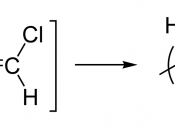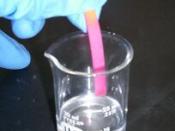Chemistry Extended Answer Question - Hydrogen Chloride
Lots of gases are formed during a chemical reaction which occurs when two or more substances react with each other. In this essay, hydrogen chloride will be researched on from the list of ammonia, sulphur dioxide and sulphur, chlorine and hydrogen chloride. The following table shows the physical and chemical properties of hydrogen chloride:
Description Colorless gas or colorless liquid
Molecular formula HCl
Molecular weight 36.46
Density 1.49 g/L @ 25ð C
Boiling point -84.9ð C (HCl gas)
Melting point -114.8ð C (HCl gas)
Solubility Soluble in water, alcohol, benzene, ether; insoluble in hydrocarbons
Conversion factor 1 ppm = 1.49 mg/m3 at 25ðC
Hydrogen chloride can be produced in many ways but it mainly involves the reaction between two or more different chemicals in order for it to be produced correctly. The most common way hydrogen chloride is produced in industry is by the controlled reaction between hydrogen and chlorine.
The equation of the reaction is as below:
H (g) + Cl (g) ============ 2HCl (g)
This process is particularly useful because hydrogen is produced in the same chloralkali process that produces chlorine, so reaction of the two gases coming from the same cell yields HCl with no byproducts. A chlorine burner using this reaction can produce a high-concentration, high-quality product. However, the reaction can proceed explosively and so careful handling and appropriate safety devices are necessary.
In contrast, the most common way hydrogen chloride is produced in a laboratory is by the reaction of a common salt, NaCl (table salt) and sulfuric acid. The equation of the reaction is as below:
NaCl (s) + H SO (aq) =========== NaHSO (aq) + HCl (g)
The reaction to NaHSO4 predominating at 150oC .The Leblanc process, an early source of HCl, has now been replaced by production from salt and sulfuric acid.
Hydrogen chloride is used in many ways in society. The first use that was identified was the manufacturing of hydrochloric acid. Hydrochloric acid is produced by dissolving hydrogen chloride in water which is shown by the following equation:
HCl (g) + H O (l) =========== H O (aq) + Cl (aq)
Hydrochloric acid is gaseous HCl or its aqueous solutions, since HCl is highly soluble in water. It dissociates to H3O+ (aq) and Cl-(aq) virtually completely and is one of the common strong acids. This shows that HCl is a strong acid.
The second use of hydrogen chloride is in the production of vinyl chloride or polyvinyl chloride (PVC). Polyvinyl chloride (PVC), also known as "vinyl," is produced in several steps. In the first step, ethylene dichloride (EDC) is produced by the chlorination of ethylene through either direct chlorination or oxychlorination. Direct chlorination reacts ethylene with chlorine. Oxychlorination is done by reacting ethylene with dry hydrogen chloride (HCl) and oxygen at temperatures generally less than 325ðC. The resulting EDC is then subjected to pressures between 20-30 atmospheres and temperatures between 550-650ðC. This process is known as pyrolysis, or thermal cracking. Equal parts of vinyl chloride monomer (VC) and hydrogen chloride (HCl) are created during this stage. The VC is then isolated.
And finally, PVC is made by the polymerization of the VC. Polymerization is a chemical reaction linking the molecules of a simple substance (monomer) together to form large molecules whose molecular weight is a multiple of that of the monomer. There are two general types of polymerization reactions, addition polymerization, and condensation polymerization. PVC is made by addition polymerization, which occurs when VCM reactive monomers unite without forming any other products. Its resulting molecular structure is similar to that of polyethylene.
During the production of hydrogen chloride, many hazards would occur as the process of making it involves places of high temperature and chemicals which are corrosive like sulfuric acid. To minimize the hazards which occur during the production of hydrogen chloride, the following precautions could be taken into practice. In industry and in laboratory work, the following precautions can be taken to minimize risk of getting injured:
i) Use respirable fume respirator or air supplied respirator when working in confined
space or where local exhaust or ventilation does not keep exposure below TLV.
ii) Wear Neoprene gloves (Industry)
ii) Wear safety glasses when handling gas.
iv) Metatarsal shoes for cylinder handling. Protective clothing where needed. Cuffless
trousers should be worn outside the shoes.


